Porto-North-Portugal.com
The best independent guide to north Portugal
Porto-North-Portugal.com
The best independent guide to north Portugal
Aveiro, Portugal; the best independent tourism guide for 2025
Aveiro is a city where water, art, and tradition merge. Graceful canals criss-cross its centre, navigated by the colourfully painted Moliceiro boats that have become its signature emblem. The city's lifeblood has always been the vast Ria de Aveiro lagoon, a unique coastal landscape that once brought great prosperity through its salt pans, seaweed harvesting, and rich fishing grounds.
This historic connection to the water has created a city with a unique and charming character. Strolling through its centre reveals a delightful blend of ornate Art Nouveau mansions, traditional fishermen's cottages, and a lively, youthful atmosphere fuelled by its university. This picturesque setting offers a surprising contrast to the wider region, which is a powerhouse of Portuguese industry and manufacturing.
Beyond the city's canals lies a region of stunning natural beauty. A short trip leads to the glorious beaches of Costa Nova, famous for its candy-striped houses lining the seafront. The wider lagoon is a haven for birdlife, while the nearby Dunas de São Jacinto Nature Reserve offers pristine forests and a wild Atlantic coastline.
This blend of urban charm and coastal beauty makes Aveiro one of the most popular and enjoyable day trips from Porto, connected by a regular and inexpensive train service. This guide will show you everything you need to discover Aveiro and its magnificent coastal region.
Highlights of Aveiro
Aveiro Canals - Explore the heart of the city from the water on a traditional Moliceiro. These gracefully painted boats navigate the three main canals, offering the definitive Aveiro experience as they glide past the city’s finest architecture. (Moliceiro tickets here)
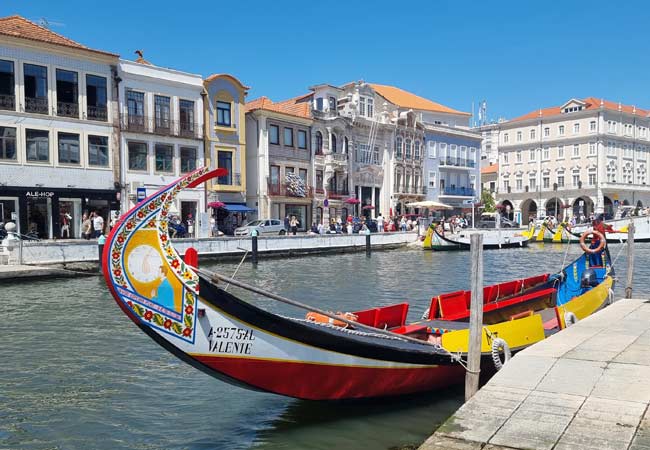
Costa Nova - A delightful beach resort just a short trip from Aveiro, famed for the vibrant, striped holiday homes that line its promenade and its magnificent sandy beach. - Guide to Costa Nova
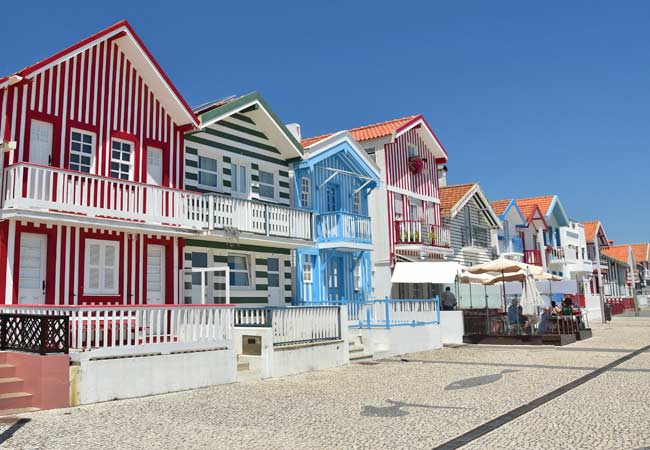
The Bairro de Beira Mar - The characterful Fishermen's Quarter of Aveiro, where cobbled streets and traditional fishermen's houses lead to a bustling fish market and excellent seafood restaurants.
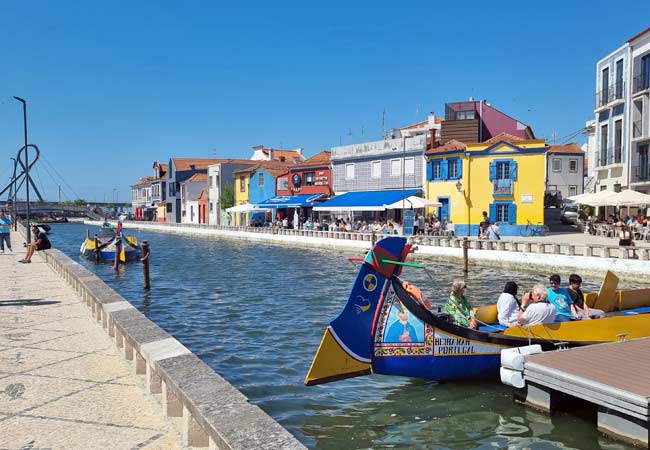
The Ria de Aveiro - The saltwater lagoon that shaped Aveiro's history. Today it is a peaceful haven for wildlife, offering tranquil walks along its shoreline and boat tours through its protected channels.

Is Aveiro the Venice of Portugal?
Aveiro is often marketed as the ‘Venice of Portugal’, and at first glance, the comparison seems apt. There are canals, elegant bridges, and graceful, gondola-like boats (the Moliceiros) gliding along the waterways.
However, this popular nickname does a great disservice to Aveiro. The comparison sets visitors' expectations for the grandeur of Venice, which the city cannot match, while completely missing its own unique charm.
Aveiro is not a miniature Venice; it is a proud Portuguese city with its own distinct history, culture, and character, rooted in the life of its lagoon.
Related articles: Attractions and sights of Aveiro
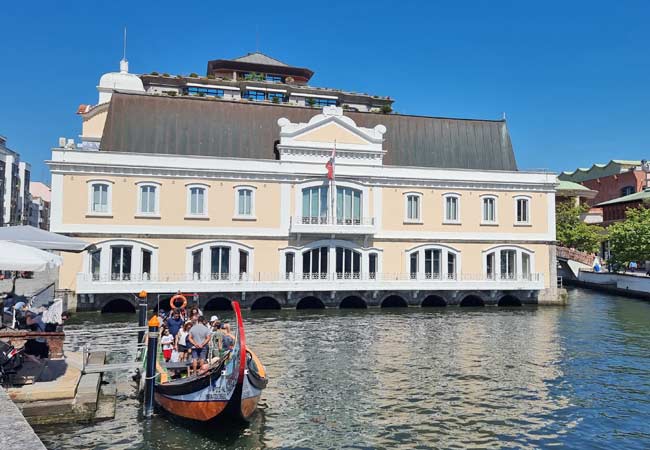
The Assembleia Municipal de Aveiro
How long to spend in Aveiro?
Aveiro is a major city, but the historic centre is relatively compact and can be seen within three hours of sightseeing. A typical day trip (map and details in the next section) is often combined with a boat tour of the canals and the Ria de Aveiro lagoon.
For a longer day trip, you could include Costa Nova, with its colourful beach houses, pretty harbour and vast beach. For most visitors, one day is enough time to explore Aveiro, but you may wish to spend one night if you are travelling between Porto and Coimbra - Aveiro is conveniently situated on the main north-south railway.
For beach focused holiday, you would want to stay in Costa Nova, as Aveiro is not situated on the Atlantic coastline but is 7km inland. Costa Nova is one of the hidden gems of Northern Portugal and an amazing location for a relaxing holiday.
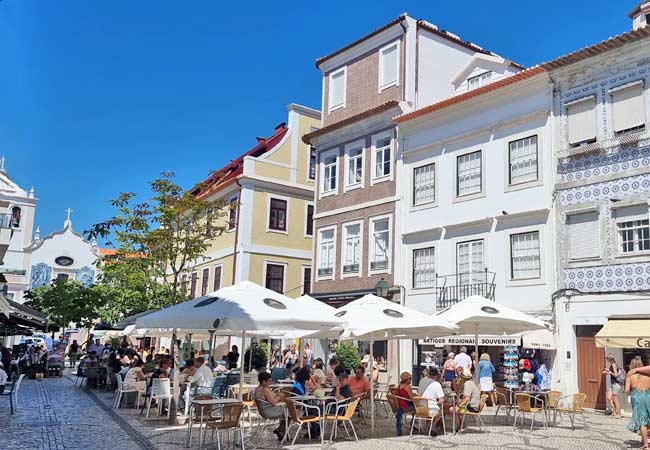
A day trip to Aveiro
Aveiro is ideally set up for a day trip from Porto or Coimbra. The city has sufficient interesting sights and activities to fill a day of sightseeing, and is conveniently connected by regular train services.
Personal opinion: For day trips from Porto, we suggest this order: Guimarães, Braga, Aveiro, Douro Valley (train or boat tour), Lamego, Vila do Conde
The interactive map below displays a suggested tour of Aveiro, which begins from the train station. The bus stop for the bus to Costa Nova is marked by point (7), and the map also includes the major sights of the Aveiro region (zoom out to see these).
Sights of Aveiro 1) Estação de Aveiro 2) Assembleia Municipal de Aveiro 3) Museu de Arte Nova 4) Praça do Peixe 5) Fisherman’s Quarter 6) Salinas de Aveiro (saltpan open-air museum) 7) bus to Costa Nova 8) Igreja da Misericórdia 9) Forum Aveiro (shopping centre) 10) Sé Catedral de Aveiro 11) Mosteiro de Jesus 12) Centro de Congressos de Aveiro
Sights around Aveiro 13) Costa Nova 14) Praia da Barra 15) Reserva Natural das Dunas de São Jacinto 16) Passadiços Ria de Aveiro
Have you considered an organised tour to Aveiro?
An organised tour is great way to discover Aveiro, especially if you are based in Porto. The standard of tours in Portugal is very high, with knowledgeable and enthusiastic guides, and tours that are designed for modern tourists. An organised tours provides the opportunity to fit so much sightseeing into a single day, while removing the hassle of public transport.
We have worked with GetYourGuide for the previous seven years, and some of their best tours of Aveiro include:
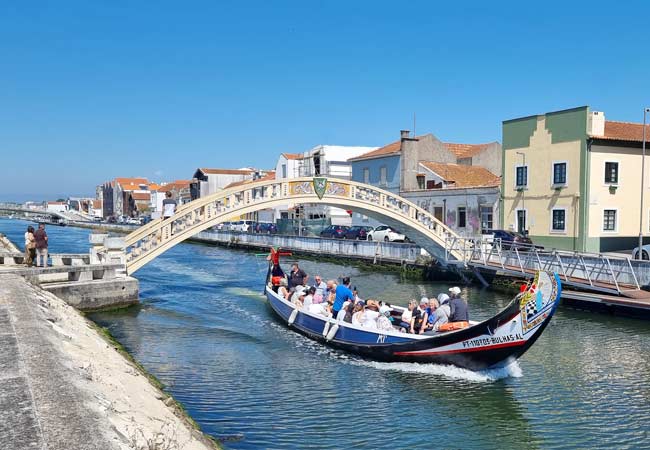
Ponte dos Carcavelos
Travel to Aveiro
Aveiro is a major transport hub, and it is very easy to travel to from popular tourist destinations. There are over 20 daily train services from Porto to Aveiro.
The train departs from the São Bento train station, takes 1h15min, and the fare is €3.90/€7.80 (single/return). From Coimbra, there are 15 daily departures to Aveiro; the journey takes 1h02min, and a single ticket cost €5.35. Both train services are operated by CP, the national train company of Portugal, and the latest timetable can be seen on their website: https://www.cp.pt/
Note: There are express trains between Porto and Coimbra that stop at Aveiro, but they are significantly more expensive, and seats have to be pre-booked in advance.
Related articles: Porto to Aveiro
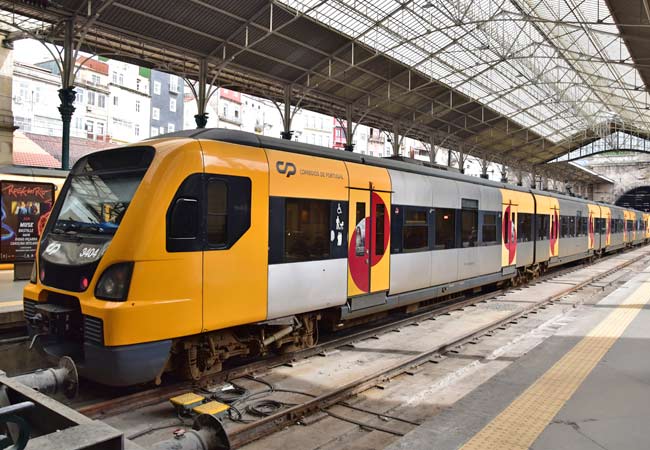
Does Aveiro have good beaches?
Aveiro is situated on the Ria de Aveiro lagoon and is not directly located on the Atlantic Ocean coastline. This means that the nearest beaches are 7 km to the west, at Praia da Barra or Costa Nova. Due to the distance, Aveiro should not be considered as a beach resort but as a charming Portuguese city.
The Praia da Barra and Costa Nova coastline is beautiful, with a pristine sandy shoreline stretching for over 5km. This western coastline of Portugal (known as the Costa da Prata) is dominated by the Atlantic Ocean, with its huge surfing waves, rugged scenery and bracing sea breezes.
To the north of the Ria de Aveiro estuary are the deserted beaches of the Reserva Natural das Dunas de São Jacinto. This sandbar peninsular had forests planted during the 18th century to stabilise the coastline and today is a protected nature park with unspoilt sandy beaches.
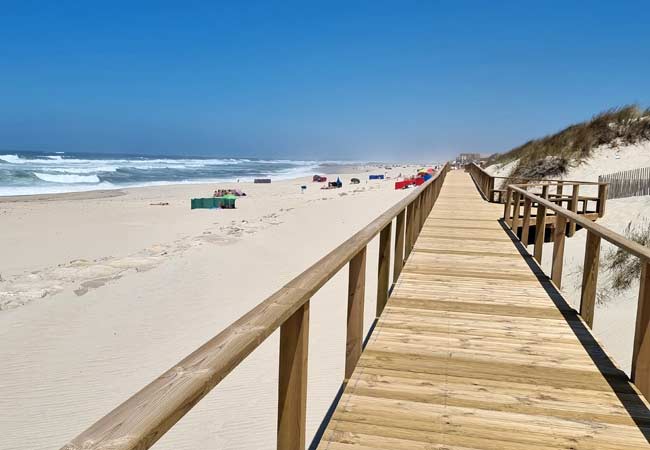
The turbulent history of Aveiro
Aveiro’s fortunes have always had a close connection to the ocean and that of the waterways which surround it. As a result, the city has experienced periods of great wealth, and devasting low points, to such an extent that the city was almost wiped out.
The Romans were the first to identify Aveiro as a harbour and considered the location as the best-sheltered harbour on the western side of the Iberian Peninsula. Up until the mid-16th century, Aveiro was a prosperous city, with a major fishing fleet and significant sea trade.
This all changed in 1575 after an incredibly powerful winter storm dredged up the seabed, forming a sandbank along the mouth of the harbour. This blocked the port and created the Ria de Aveiro lagoon. Along with losing all of the prosperous trade routes, the stagnant lagoon bred diseases, which ravaged the population. In less than twenty years the population of Aveiro went from 30,000 to less than 5,000.
The resilient city did eventually recover, and by the early 19th century it was an industrial centre for kelp farming and salt production. The kelp formed the basis of early fertilisers and was harvested from the lagoon and transported by the Moliceiros boats. The high-quality salt from the Ria de Aveiro was traditionally used to make Bacalhao, the salted and dried codfish, which is loved by the Portuguese.
At the start of the 20th century, Portuguese emigrants who had left Portugal to find riches in Brazil, returned and recreated its extravagant Art Nouveau architecture in the houses they built along the canals. Today Aveiro is a major university city, and the region is the manufacturing centre of Portugal.
Ovos Moles de Aveiro…. Yummy!
No trip to Aveiro is complete without trying the local delicacy, Ovos Moles de Aveiro. This confectionery is made from sweetened egg yokes, which are encased in a thin candy waiver, and often styled as a barrel or fish.
The direct translation of Ovos Moles de Aveiro is “soft eggs of Aveiro”, which sums up the little cakes perfectly.
As with many of Portugal’s traditional cakes, they originated from the convents and monasteries, and the Ovos Moles first were first produced in the Mosteiro de Jesus de Aveiro.
The nuns used the egg whites to starch their habits, so there was an abundance of egg yolks, and these were used to make sweet pastries and cakes. With the expulsion of all religious orders in the 19th century, the culinary expertise was transferred to the local bakeries.
Later, Aveiro became a major stop along the Lisbon-Porto railway, women in traditional dress would sell the cakes onboard the train, and the taste for Ovos Moles spread across the whole of Portugal.

If you've found our content valuable, we'd welcome your support.
The digital publishing landscape has evolved significantly. As a small independent publisher, we face growing challenges. Search engines increasingly favour paid content over organic results, while AI-generated content often reproduces original work without attribution.
To support our work, please consider bookmarking this page (press Ctrl + D) for quick access. If you find an article helpful, we'd be grateful if you'd share it with friends on social media.
For specific questions, please see our Reddit community at r/LisbonPortugalTravel.
Should you notice any outdated or incorrect information, please contact us at [email protected]
Thank you for helping us continue to provide valuable content in an increasingly challenging digital environment.























